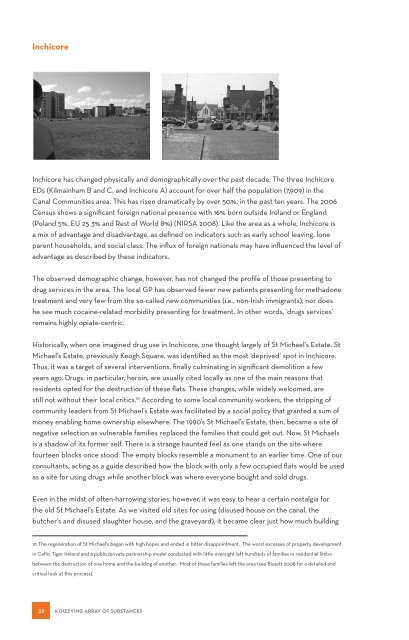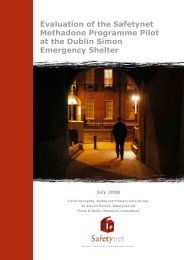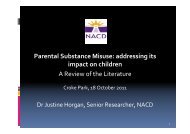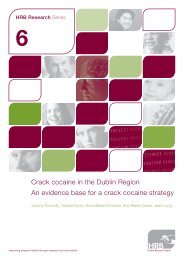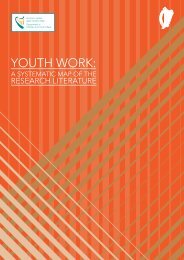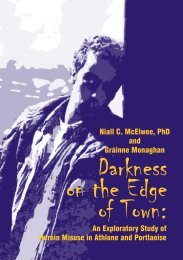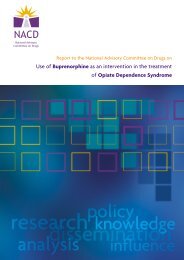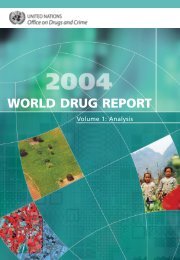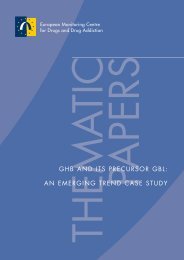A Dizzying Array of Substances.pdf - department of anthropology
A Dizzying Array of Substances.pdf - department of anthropology
A Dizzying Array of Substances.pdf - department of anthropology
You also want an ePaper? Increase the reach of your titles
YUMPU automatically turns print PDFs into web optimized ePapers that Google loves.
InchicoreInchicore has changed physically and demographically over the past decade. The three InchicoreEDs (Kilmainham B and C, and Inchicore A) account for over half the population (7,909) in theCanal Communities area. This has risen dramatically by over 50%, in the past ten years. The 2006Census shows a significant foreign national presence with 16% born outside Ireland or England(Poland 5%, EU 25 3% and Rest <strong>of</strong> World 8%) (NIRSA 2008). Like the area as a whole, Inchicore isa mix <strong>of</strong> advantage and disadvantage, as defined on indicators such as early school leaving, loneparent households, and social class. The influx <strong>of</strong> foreign nationals may have influenced the level <strong>of</strong>advantage as described by these indicators.The observed demographic change, however, has not changed the pr<strong>of</strong>ile <strong>of</strong> those presenting todrug services in the area. The local GP has observed fewer new patients presenting for methadonetreatment and very few from the so-called new communities (i.e., non-Irish immigrants), nor doeshe see much cocaine-related morbidity presenting for treatment. In other words, ‘drugs services’remains highly opiate-centric.Historically, when one imagined drug use in Inchicore, one thought largely <strong>of</strong> St Michael’s Estate. StMichael’s Estate, previously Keogh Square, was identified as the most ‘deprived’ spot in Inchicore.Thus, it was a target <strong>of</strong> several interventions, finally culminating in significant demolition a fewyears ago. Drugs, in particular, heroin, are usually cited locally as one <strong>of</strong> the main reasons thatresidents opted for the destruction <strong>of</strong> these flats. These changes, while widely welcomed, arestill not without their local critics. 10 According to some local community workers, the stripping <strong>of</strong>community leaders from St Michael’s Estate was facilitated by a social policy that granted a sum <strong>of</strong>money enabling home ownership elsewhere. The 1990’s St Michael’s Estate, then, became a site <strong>of</strong>negative selection as vulnerable families replaced the families that could get out. Now, St Michaelsis a shadow <strong>of</strong> its former self. There is a strange haunted feel as one stands on the site wherefourteen blocks once stood. The empty blocks resemble a monument to an earlier time. One <strong>of</strong> ourconsultants, acting as a guide described how the block with only a few occupied flats would be usedas a site for using drugs while another block was where everyone bought and sold drugs.Even in the midst <strong>of</strong> <strong>of</strong>ten-harrowing stories, however, it was easy to hear a certain nostalgia forthe old St Michael’s Estate. As we visited old sites for using (disused house on the canal, thebutcher’s and disused slaughter house, and the graveyard), it became clear just how much building10 The regeneration <strong>of</strong> St Michael’s began with high hopes and ended in bitter disappointment. The worst excesses <strong>of</strong> property developmentin Celtic Tiger Ireland and a public/private partnership model conducted with little oversight left hundreds <strong>of</strong> families in residential limbobetween the destruction <strong>of</strong> one home and the building <strong>of</strong> another. Most <strong>of</strong> these families left the area (see Bissett 2008 for a detailed andcritical look at this process).32A DIZZYING ARRAY OF SUBSTANCES


